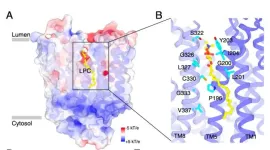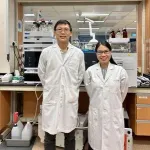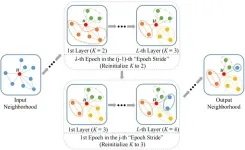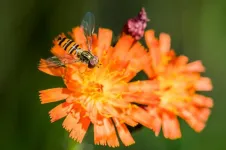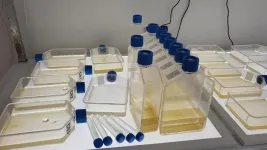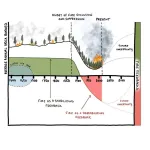(Press-News.org)
Accumulation of fat molecules is detrimental to the cell. Researchers from the Yong Loo Lin School of Medicine, National University of Singapore (NUS Medicine), have made a breakthrough in understanding how our cells manage to stay healthy by recycling important fat molecules. Their study, published in the journal Proceedings of the National Academy of Sciences (PNAS), reveals how a protein called Spinster homolog 1 (Spns1) helps transport fats out of cell compartments known as lysosomes.
Led by Associate Professor Nguyen Nam Long, from the Department of Biochemistry and Immunology Translational Research Programme (TRP) at NUS Medicine, the team found that Spns1 is like a cellular gatekeeper which can help to move a type of fat molecule called lysophospholipids to the lysosome, the cell’s “recycling centre”. These fat molecules are then reused for cell functions. Spns1is crucial in maintaining cellular health by ensuring fat recycling is efficient and that harmful fat build-up is prevented.
Fats and other cellular materials reach the lysosome through three main pathways: endocytosis, phagocytosis, and autophagy. In endocytosis, the cell takes in materials from outside by wrapping them within vesicles, which carry them to the lysosome for breakdown. In phagocytosis, immune cells such as macrophages act like the body's cleanup crew, swallowing up large particles like damaged cells or germs and sending them to lysosomes. Lastly, in autophagy, the cell cleans up its own damaged parts, such as old mitochondria, by wrapping them in a membrane bubble called an autophagosome. This bubble then merges with the lysosome, where the contents are broken down and recycled to keep the cell healthy.
Once fats are broken down in the lysosome, they serve several important roles in the cell. One is membrane repair and maintenance. The broken-down fat components, such as phospholipids and sphingolipids, are reused to rebuild and maintain the cell’s protective membranes. Fats also help with energy production, as some of them are processed to provide fuel for the cell’s activities. Additionally, certain fats, like sphingosine-1-phosphate (S1P), play a crucial role in cellular communication. These signalling molecules help cells coordinate important processes, such as growth, movement, and survival, ensuring that the body functions smoothly.
In a previous study, the NUS Medicine team has shown that if Spns1 does not work properly, it leads to a buildup of lipid waste inside cells, causing diseases known as lysosomal storage diseases (LSD) in humans. LSDs are a group of over 50 rare genetic disorders caused by problems in the lysosome’s recycling process. Diseases like Gaucher disease, Tay-Sachs disease, Niemann-Pick disease, and Pompe disease result from waste buildup in cells, leading to serious health issues. Dysfunctions of the lysosomal recycling pathway are also found in Parkinson’s and Alzheimer’s diseases.
In collaboration with Professor Xiaochun Li’s group from the University of Texas Southwestern Medical Center (UTSW), the team used a technology called cryoelectron microscopy (cryo-EM) and the functional readouts to take images of Spns1’s interactions with a specific type of fat called lysophosphatidylcholine (LPC), one of the recycled lysophospholipids in the lysosome. This gave them a better understanding of how Spns1 works and how it senses changes in the cell’s environment to perform its job.
“Lysosomal storage disorders are a group of rare genetic diseases that occur when the lysosome fails to recycle important molecules. Our research shows that Spns1 plays a key role in preventing these diseases by ensuring that fats are properly transported out of the lysosome,” said A/Prof Nguyen. “We now understand more about how our cells recycle these fat molecules at atomic level, and this could help us develop new treatments for diseases where Spns1 fails to work as intended.”
The team also ran experiments to confirm that the protein is essential for moving fats out of lysosomes and that certain parts of Spns1 are crucial for its function. The study revealed the following key findings:
Spns1 acts like a gate, opening and closing to let fats out of the lysosome.
It relies on specific signals from the cell’s environment to know when to open and close.
Mutations in Spns1 can cause problems with fat transport, leading to the buildup of waste inside cells and human diseases.
“We’re excited about the potential of this research to make a real difference for patients with these rare diseases,” said Ms Ha Thi Thuy Hoa, co-first author of the paper, from the Department of Biochemistry and Immunology TRP at NUS Medicine. “While this study captured Spns1 in the state where it opens toward the lysosome to pick up fats, we are now working to understand the opposite state, where it opens from the lysosome toward the rest of the cell. This will help us fully understand how Spns1 completes its transport cycle.”
The researchers are also exploring potential small molecules that could modulate SPNS1 activity, with the aim of developing targeted drugs for lysosomal storage diseases.
END
Classic Graph Convolutional Networks (GCNs) often learn node representation holistically, which would ignore the distinct impacts from different neighbors when aggregating their features to update a node's representation. Disentangled GCNs have been proposed to divide each node's representation into several feature channels. However, current disentangling methods do not try to figure out how many inherent factors the model should assign to help extract the best representation of each node.
To solve the problems, a research team led by Chuliang WENG published their new ...
Male hoverflies are outflown by females when it comes to long-distance migration, new research shows.
Marmalade hoverflies leave northern Europe each autumn to escape the cold winter.
The study – by the University of Exeter – compared the number of males and females migrating at a northern point (Denmark) and further south (Spain).
At the northern point, 50% of hoverflies were male and 50% were female – but at the southern point about 90% were female, suggesting males are “poor long-distance fliers”.
“We carried out a range of tests and found females were better adapted for long-distance ...
CORVALLIS, Ore. – Certain groups of consumers appear to be open to drinking smoke-impacted wines, a finding in a new study that could provide market opportunities for winemakers increasingly dealing with the effects of wildfire smoke on grapes.
The study by researchers at Oregon State University and in New Zealand found that consumers, particularly those that like smokey flavors in food and beverages, are open to drinking smoke-impacted wines. They also found that the type of information on the label can modulate consumer acceptance.
“This ...
New research has highlighted microalgae’s capacity as a solution in the fight against climate change, but researchers warn that “smart microalgal bioprospecting” is needed to unlock its full potential.
The study highlights the vast, largely unexplored capacity of microalgae to mitigate CO2 emissions while driving sustainable industry.
“Microalgae have remarkable properties that make them an ideal tool for tackling climate change,” said lead author, PhD candidate Joan Labara Tirado from the University of Technology Sydney (UTS).
The review paper, The need for smart microalgal bioprospecting was ...
Fewer wildfires burn in North American forests today than in previous centuries, increasing the risk of more severe wildfires, according to research published this week in Nature Communications. The findings may seem counterintuitive, but frequent low-lying surface fires often maintain balance in forests by reducing fuel sources across large areas.
The new study led by the Cooperative Institute for Research in Environmental Sciences (CIRES) at the University of Colorado Boulder and the U.S. Forest Service’s Rocky Mountain Research Station ...
Older people have greater general happiness, life satisfaction and sense of purpose than they did before the Covid-19 pandemic.
That’s according to a new study which tracked 3,999 over 50s in England for 11 years, published today in the peer-reviewed journal, Aging and Mental Health.
Analysing data to understand positive psychological well-being and depression within this group, an expert team from UCL (University College London), funded by the National Institute of Ageing, a consortium of UK government departments coordinated by the National Institute ...
Dr. Alison Altman, an assistant professor in the Texas A&M Chemistry Department, has received a National Science Foundation (NSF) CAREER Award, which supports early-career faculty in research and education. The award recognizes her work on underexplored elements of the periodic table and her dedication to teaching. For Altman, it’s a launchpad for future discoveries.
“It’s an honor to receive this award, as it acknowledges not just my research program but also my teaching efforts,” ...
Micro- and nanoscale plastic particles in soil and water can significantly increase how much toxic chemicals plants and human intestinal cells absorb, according to two new studies from Rutgers Health that raise fresh concerns about food safety from plastic pollution.
The first study in NanoImpact found that lettuce exposed to both nanoscale plastic particles and common environmental pollutants such as arsenic took up substantially more of the toxic substances than plants exposed to the pollutants, alone confirming the risks of polycontamination of our food chain. A companion study in Microplastics journal showed ...
Seeking to understand what constitutes a healthy vaginal microbiome, a global research collaboration that includes a Rutgers-New Brunswick scientist has reported a series of findings, including identifying which bacteria thwart vaginal disease and determining that microbiomes vary significantly across human populations.
Authors of the study, published in Trends in Microbiology, are part of a Belgium-based initiative called the Isala Sisterhood. Members of the group aim to inspire research on microbiomes worldwide by creating a “reference map” of vaginal microbiota. Launched in 2020 at the University of Antwerp, the project has expanded to include more than 3,000 ...
The National Academy of Engineering (NAE) today announced that University of Pittsburgh Professor Fang Peng, an internationally acclaimed power electronics researcher, is among the newest cohort elected to the academy. The NAE is recognizing Peng for “contributions to the development of high-powered electronic technologies for advanced power grid and energy conversion.”
Peng, the RK Mellon Endowed Chair Professor of Electrical and Computer Engineering and Director of the Energy GRID Institute at Pitt’s Swanson School of Engineering, ...
